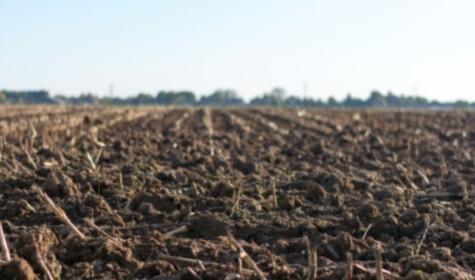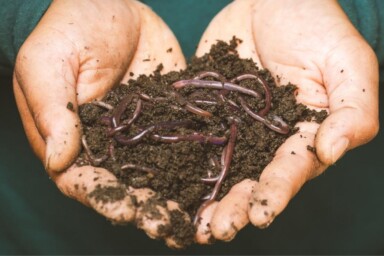This article was originally published on the Food and Global Security website.
Perhaps surprisingly, given that I worked for more than 20 years for an organisation called the Soil Association, my striving to understand the full significance and importance of the soil is still an evolving process which continues to be inspired and illuminated by ongoing revelations derived from my farming, my reading and my role in the Sustainable Food Trust. I thought it would be relevant to reflect on some of these recent milestones, particularly bearing in mind the various planetary emergencies which are now occupying the attention of citizens throughout the world in the run up to the COP26.
Everyone now knows that the soil is one of the world’s great carbon banks, actually second only to the oceans in its capacity, and arguably the only element of the Earth’s bank of natural capital where changes in farming practice could sequester significant amounts of CO2 out of the atmosphere during the next 10 years. For that reason alone, it deserves to receive a huge amount of attention at the Glasgow summit. In writing this, I am mindful of the vision and leadership shown by the French minister Stéphane Le Foll at COP21 in Paris, launching as he did the so called ‘Quatre pour Mille’ (4 per 1000) initiative inviting all farmers to increase their soil carbon bank by 0.4% per year. Many governments and organisations signed up to this initiative but, due to the lack of financial incentives and the absence of adequate record keeping, little progress has been made towards achieving the French minister’s objectives, which is why the COP26 should be seen as a huge opportunity to implement the scheme.
Referring to the goal of increasing soil carbon places an emphasis on the physical, whereas in fact the soil is also a biological entity, containing as it does a multitude of micro-organisms and higher life forms. One way to understand this is to use the analogy of stomachs and to visualise the soil as the collective stomach of all plants on the planet; this is actually an accurate description because although plants don’t have an internalised stomach, 30% of the outcome of photosynthesis is exuded in the form of sugary saps into the root zones of plants, nourishing a symbiotic community of micro-organisms upon which the plant depends for its digestion. This example alone is illustrative of our evolving understanding of the world of soil which has been highlighted through the study of the human microbiome, in other words our digestive system, which can be understood in very similar ways – we eat food which feeds our stomach flora upon which we depend for our own digestion.
So, the soil can be seen as an organism or an ecosystem, playing a central role in transforming the mineral matter of planet Earth into that thin biological film upon which all terrestrial life depends. It would be no overstatement to say that upon this thin layer of organic matter laid down over millennia, quite literally the future of civilisation depends. As mentioned at the beginning of this article, there is nothing new in this observation, but it has taken me a lifetime of farming and advocacy for sustainable agriculture to understand its true significance.
There are so many wonderful examples of individuals who have understood and written about the true importance of soil. I’m thinking here of Sir Albert Howard who described the health of soil, plants, animals and people as forming one indivisible whole, or his wife Louise Howard who continued his work in a book entitled The Earth’s Green Carpet. Much later John Seymour, the self-sufficiency guru of the 1960s and 70s, coined the phrase ‘the fat of the land’ in his book of the same name.
From my perspective, the soil is the fat of the land. It represents a resource laid down in times of abundance which acts as a reserve to nourish future generations of plants, animals and people.
Having now farmed for 48 years on the same piece of land, observing the impact of my actions on the soil, I have reached the conclusion that the future of humanity and its capacity to survive the triple threats of climate change, biodiversity loss and declining public health, hinges on the capacity of farmers not merely to maintain the fertility of our agricultural soils, but actually to rebuild them. Could this be possible? I think the answer is yes, once again derived from my own observations and the impact of my farming practices, both successes and failures, over time.
Here are a few observations about what needs to happen now about the potential to build soil and soil fertility based on this experience.
Farming must transition from the extractive to a regenerative phase. This can only be achieved through the introduction of crop rotations with a fertility-building phase which in the UK would normally be from three to five years of grasses, legumes and herbs normally grazed by cattle and sheep, thus producing food humans can eat from the fertility-building element of the rotation.
On my farm I have had the privilege of observing up to five seven-year rotation cycles and the impact on soil fertility outcomes, during all of which time I have not used any chemical fertilisers or pesticides. Despite not having kept consistent or comprehensive records of the impact of this system on soil fertility outcomes, the data I have recorded plus my observations on crop yields, convinced me that this form of regenerative farming practice can not only build soil organic matter, but actually build soil. This differentiation is absolutely crucial because whilst the current orthodoxy of the scientific community (as reflected in the Climate Change Committee’s Stategy for UK agriculture) fails to factor in any soil carbon sequestration; their justification for this exclusion is based on the failure of the scientific community not only to monitor the soil carbon impacts of regenerative agriculture, but also to factor in the potential of regenerative farming to actually build soil. As an example, my own farming practices might increase the soil organic matter, say from 5% to 7%, but if I was also building more soil this would not be captured through the existing measurement mechanisms.
This leads to a vital challenge of which farmers throughout the world are now acutely aware, namely the capacity of the scientific community to accurately measure soil carbon stocks.
As mentioned above, the tantalising prospect of paying farmers to act as soil carbon stewards was explored and promoted by the French Agriculture Minister, Stéphane Le Foll at the COP21 climate change conference in Paris, setting a target for all the world’s farmers of raising their carbon stock by 0.4% per year. In the six years since the launch of this initiative, no single nation has yet claimed they have delivered this target. Yet, if it was achieved globally, this would enable the world’s agricultural soils to become the single biggest contribution towards climate change reversal by, over time, sequestering up to 100 parts per million of CO2 back into the world’s largest carbon bank (after the oceans), the soil.
I’ve focused here on soil carbon, but in reality, carbon should be seen as a proxy for soil fertility which is not merely carbon in both living, dying and dead forms, but also a remarkable, mysterious, even magnificent ecosystem, largely hidden from our eyes, upon which all above ground life depends.
Thankfully the soil science community is now shuffling towards a slightly embarrassing u-turn and realising in the process that it has been the obsession with physics and chemistry and the application of fertilisers and pesticides that has allowed farmers to largely destroy the biological element of soil fertility on which the future of life on Earth depends.
Homing in on UK politics, there are encouraging signs that governments and farming leaders alike have recognised the imperative of improving soil fertility and carbon stocks, as evidenced by , and currently in the discussions about the shape and incentive mix of the coming Environmental Land Management scheme. I read in the farming press this week that a key conclusion of a survey was that farmers wanted to see stronger incentives at the heart of the ELMs scheme to help them move towards net zero, the principle factor of which, of course, should be incentivising building soil carbon stocks.
Composting
In completing this homage, it would be inappropriate not to make mention of the importance of composting. Farmers in general and livestock farmers in particular, of which I am one, have come very late to the composting party. Historically we have tended to stack our farmyard manures in anaerobic saturated heaps, relying solely on the chemical nutrients, nitrogen, phosphorus and potash to nourish subsequent crops. This despite a massive body of observations and evidence stretching back over a century of the incredible power of compost to accelerate soil fertility building.
Cynics often point out that people say they are going to do something and then don’t actually do it, such as buying organic food, but they fail to acknowledge that with all of us the intention precedes the action. It is exactly the same with composting; I’ve been thinking of introducing it for years but have only finally got around to it very recently.
I first witnessed the transformative power of composting some 15 years ago when I visited the Sekem community in Egypt where Helmy Abouleish and his father have reclaimed lifeless desert soils and turned them into fertile fields producing an abundant range of nutritious crops, solely by introducing large volumes of composted wastes from wherever they could find them including biomass and municipal waste from Cairo.
Eventually I was shamed into action and have recently covered and contained my composting area, as a result of which in 2021 we recently spread a field with the best compost we’ve ever made here in 48 years, covering a newly established herbal ley. Our 80 Ayrshire dairy cows have just finished grazing this field of around nine acres which nourished them for eight days, a remarkable milk-stimulating phenomenon which has made me realise that in terms of my capacity to further build the soil fertility over which I have temporary stewardship, I am still only in the foothills of the potential which lies ahead.
I believe this situation is applicable to the majority of the world’s farmers – in front of us is a monumental task, we need not only to maintain but to build soil fertility, which we must and can do by commencing a new relationship of the soils under our management, harvesting and growing the body of experience and evidence of the pioneers of soil building both historic and living. If we embrace this challenge at the scale which is necessary, namely globally, we might just be able to avoid the kind of collapse which Jared Diamond has so brilliantly chronicled in his book of that title.





